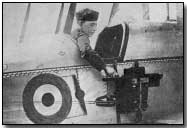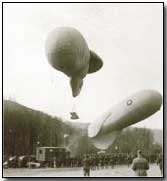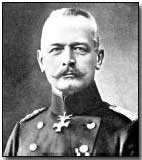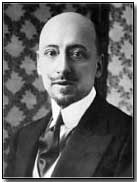The War in the Air - Observation and Reconnaissance
 General Foch is reported to have said that "aviation is a good sport, but for the army it
is useless". This reflected a widely held scepticism about aircraft, which is not surprising considering how frail and unreliable they were in 1914.
General Foch is reported to have said that "aviation is a good sport, but for the army it
is useless". This reflected a widely held scepticism about aircraft, which is not surprising considering how frail and unreliable they were in 1914.
The military did, however, see some value in taking advantage of the aircraft's height for an improved view of the battle-field. They were influenced in this, perhaps, by the successful use in earlier conflicts of tethered lighter-than-air balloons, such as those used in the American civil war. The airplane, they felt, could augment and enhance the balloons - an airplane could see things on the far side of a hill that even a balloon could not - but they still felt that the most important tool for reconnaissance would be the cavalry.
Within the first months of the war - even before trench warfare completely sidelined the cavalry - the value of aerial reconnaissance proved itself. General John French acknowledged that without the timely information provided by the RFC, Von Kluck's army would have succeeded in encircling his forces at Mons.
Shortly after, at the crucial First Battle of the Marne, General Joseph-Simon Gallieni used information provided by the French Armee de l'Air to send troops to the exposed German flank.
On the Eastern Front, both the Russians and the Germans were flying reconnaissance missions. In the prelude to the Battle of Tannenberg, General Alexander Samsonov was to tragically ignore warnings provided by his pilots. Field Marshal von Hindenburg did not. Almost all of Samsonov's army was either killed or captured. Samsonov committed suicide. After the stupendous German victory von Hindenburg acknowledged that "without airmen there would have been no Tannenberg."
The Russians learnt their lesson, though, and from 1915 onwards had an excellent long distance reconnaissance aircraft in the Ilya Murometz (discussed in the section on bombing). In the Brusilov offensive of 1916 aerial reconnaissance provided the Russian army with detailed maps of enemy positions.
 Reconnaissance
missions were dangerous. They were usually carried out by a crew of
two. The pilot was required to fly straight and level to allow the
observer to take a series of overlapping photographs. There was no
better target for anti-aircraft guns, no easier prey for stalking fighters.
Reconnaissance
missions were dangerous. They were usually carried out by a crew of
two. The pilot was required to fly straight and level to allow the
observer to take a series of overlapping photographs. There was no
better target for anti-aircraft guns, no easier prey for stalking fighters.
Long range reconnaissance meant flying well behind the front lines. Navigation on such flights was often a problem, and should the plane develop any mechanical trouble (as they often did) a friendly field to put down in was a long distance away. The German reconnaissance pilots had an advantage over their French and British counterparts in this respect, as the predominant winds blew from the west.
Artillery observation also required a crew of two. It was a complex business. The wireless equipment was too bulky and heavy for planes to carry both a transmitter and a receiver, so the aircraft flew with a transmitter only.
A plane would service a particular artillery battery, and before takeoff the battery's target was confirmed. Once in the air the observer had to identify his battery and the target. He would then transmit a message ordering it to fire. He could usually differentiate shells that belonged to his battery by measuring the time from when they had fired till the explosion in the vicinity of the target.
From 1915 onwards the corrections, transmitted in Morse, were in the "clock code": a letter was used to indicate the distance from the target (the letters Y, Z, A, B, C, D, E and F representing distances of 10, 25, 50, 100, 200, 300, 400 and 500 yards respectively) and a number in the range 1-12 representing the direction from the target (with 12 indicating due north of the target, and 6 representing due south of the target).
The RFC pioneered successful artillery spotting at the Battle of the Aisne. A feature of this battle, which was quite typical of the entire Western Front, was that the Germans occupied higher ground. After the first two days the German gun positions were never visible to the British, being hidden behind the Chemin des Dames ridge. The daily reconnaissance and observation flights were an absolute necessity for the British gun batteries.
As in reconnaissance flights, artillery observation required the planes to fly steady, predictable routes. In addition to anti-aircraft fire and enemy fighters, observation aircraft suffered a third danger, and this was from the artillery shells themselves. They typically flew at an altitude similar to the apex of the artillery shell's flight, and they flew along a line between the guns and their targets.
It was not unusual for the pilot or observer to actually see the shell as it stopped at the top of its climb before plummeting downward. It was not unknown for the planes to be hit by those shells.
 Artillery
observation became so important that part of
Falkenhayn's strategy at
Verdun
was to blind the French artillery by knocking out their observation planes
and balloons. At the time the Germans had control of the air, and the
losses suffered by the observation aircraft were appalling.
Artillery
observation became so important that part of
Falkenhayn's strategy at
Verdun
was to blind the French artillery by knocking out their observation planes
and balloons. At the time the Germans had control of the air, and the
losses suffered by the observation aircraft were appalling.
Nevertheless they continued flying and the French artillery was not blinded. The bravery of the airmen in fulfilling this dangerous and unglamorous work is seldom remarked.
There were some military problems that only a plane could solve. A prime example is the hunt for the German light cruiser the Königsberg. At the outbreak of the war she was based in Dar-es-Salaam in east Africa, from where she attacked British shipping.
Pursued by more powerful British warships, she entered the Rufiji river delta and hid upstream. The deeper draught British cruisers could not follow. Having lost contact with the Königsberg the navy acquired a Curtis flying boat - one of the only aircraft then in Africa - in order to search for the ship. The Curtis, using an improvised Ford motor car radiator to replace its own damaged one, located the Königsberg in November of 1914, but in a later flight the plane was brought down by rifle fire and the pilot captured.
The Königsberg remained trapped upstream until June of 1915 when the shallow draught river monitors Severn and Mersey could be brought out from Britain. They were accompanied by 4 aircraft of the RNAS (Royal Navy Air Service) - 2 Caudron G3s, and 2 Farman F27s.
These wireless equipped aircraft were to be used for spotting, as the Severn and Mersey could not risk coming within visual sight of the more powerful Königsberg. During late June the small force of aircraft practiced cooperation with the monitors, but one aircraft of each type was damaged during these practice runs.
The first artillery duel between the Königsberg and the monitors took place on the 6th of July 1915, and ended with neither side gaining a victory. The aerial spotting had been inaccurate, because the Severn and Mersey were firing together, and the observers could not differentiate which ship had fired which round. They were further confused because the shells often landed in soft mud and did not explode at all.
The Severn and Mersey returned on the 11th of July. This time each ship fired on its own, and the Königsberg was eventually bracketed and sunk under a withering fire. Before she went under she had her revenge on the planes. She managed to damage the Farman with one of her two remaining guns. As the plane descended to a crash landing the observer continued transmitting his clock code corrections to the Severn.
 Perhaps
the best reconnaissance plane of the war was the Italian Ansaldo SVA 5.
This plane, produced in both single seater and two seater variants, had a
range and altitude allowing it to cross the Alps, and with a top speed of
230 km/h (143 mph) it could fly fast enough to outrun enemy fighters.
Perhaps
the best reconnaissance plane of the war was the Italian Ansaldo SVA 5.
This plane, produced in both single seater and two seater variants, had a
range and altitude allowing it to cross the Alps, and with a top speed of
230 km/h (143 mph) it could fly fast enough to outrun enemy fighters.
On the 9th of August 1918 a flight of seven single seat SVAs and one two seater made a historic 1,126 km (700 mile) flight to Vienna to drop propaganda leaflets on the city. The observer in the two seater was the poet/airman Gabriel D'Annunzio, who had penned the text on the pamphlets.
The twin duties of artillery observation and reconnaissance remained the most important utilization of aircraft throughout the war. The number of sorties flown on these missions far outweighed the number of missions flown on all other missions combined. It was more important, if less romantic, for a fighter pilot to shoot down an observation plane than to shoot down another fighter. More than half of Manfred von Richthofen's record setting 80 victories were scored against reconnaissance and observation planes.
Article contributed by Ari Unikoski
Photographs courtesy of Photos of the Great War website
Next - Fighters - Early Experimentation
"Bully Beef" comprised cans of boiled or pickled beef used by the British Army.
- Did you know?
